-
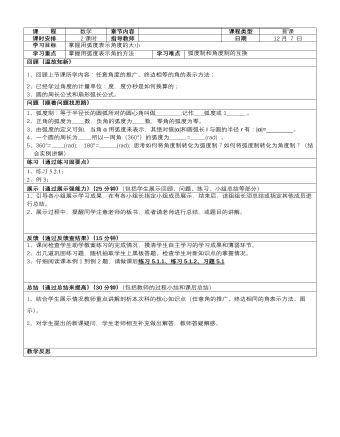
【高教版】中职数学基础模块上册:5.2《弧度制》优秀教案
课 程数学章节内容 课程类型新课课时安排2课时指导教师 日期12月 7 日学习目标掌握用弧度表示角度的大小学习重点掌握用弧度表示角的方法学习难点弧度制和角度制的互换回顾(温故知新)1、回顾上节课所学内容:任意角度的推广、终边相等的角的表示方法; 2、已经学过角度的计量单位:度,度分秒是如何换算的; 3、圆的周长公式和扇形弧长公式。问题(顺着问题找思路)1、弧度制:等于半径长的圆弧所对的圆心角叫做__________,记作____弧度或1________。 2、正角的弧度为_____数,负角的弧度为_____数,零角的弧度为零。 3、由弧度的定义可知,当角α用弧度来表示,其绝对值|α|和圆弧长l与圆的半径r有:|α|=________。 4、一个圆的周长为_____,所以一周角(360°)的弧度为_______=______(rad) 。 5、360°=_____(rad); 180°=_______(rad); 思考如何将角度制转化为弧度制?如何将弧度制转化为角度制?(结合实例讲解)练习(通过练习固要点)1、练习5.2.1; 2、例3;展示(通过展示强能力)(25分钟)(包括学生展示回顾、问题、练习、小组总结等部分)1、引导各小组展示学习成果,在有各小组长指定小组成员展示,结束后,该组组长须总结或指定其他成员进行总结。 2、展示过程中,提醒同学注意老师的板书,或者请老师进行总结,或题目的讲解。
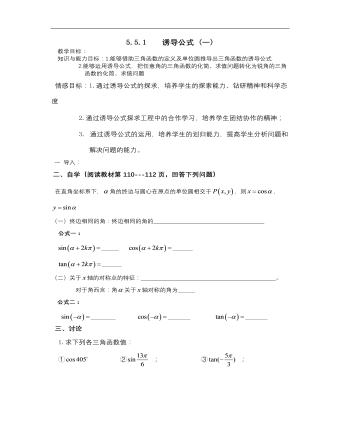
【高教版】中职数学基础模块上册:5.5《诱导公式》优秀教案
教学目标:知识与能力目标:1.能够借助三角函数的定义及单位圆推导出三角函数的诱导公式 2.能够运用诱导公式,把任意角的三角函数的化简、求值问题转化为锐角的三角函数的化简、求值问题情感目标:1.通过诱导公式的探求,培养学生的探索能力、钻研精神和科学态度 2.通过诱导公式探求工程中的合作学习,培养学生团结协作的精神; 3. 通过诱导公式的运用,培养学生的划归能力,提高学生分析问题和解决问题的能力。 一导入:二、自学(阅读教材第110---112页,回答下列问题) 在直角坐标系下,角的终边与圆心在原点的单位圆相交于,则,(一)终边相同的角:终边相同的角的 公式一:_______ ________________(二)关于轴的对称点的特征: 。对于角而言:角关于轴对称的角为_______公式二:__________ _________ _________
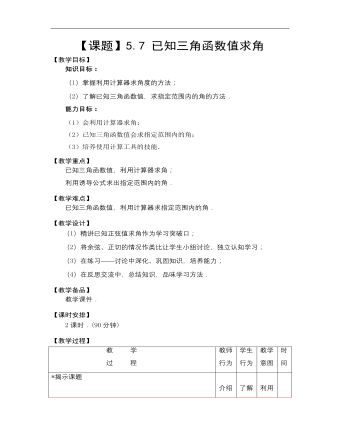
【高教版】中职数学基础模块上册:5.7《已知三角函数值求角》优秀教案
【教学目标】知识目标:(1)掌握利用计算器求角度的方法;(2)了解已知三角函数值,求指定范围内的角的方法.能力目标:(1)会利用计算器求角;(2)已知三角函数值会求指定范围内的角;(3)培养使用计算工具的技能.【教学重点】已知三角函数值,利用计算器求角;利用诱导公式求出指定范围内的角.【教学难点】已知三角函数值,利用计算器求指定范围内的角.【教学设计】(1)精讲已知正弦值求角作为学习突破口;(2)将余弦、正切的情况作类比让学生小组讨论,独立认知学习;(3)在练习——讨论中深化、巩固知识,培养能力;(4)在反思交流中,总结知识,品味学习方法.【教学备品】教学课件.【课时安排】2课时.(90分钟)【教学过程】 教 学 过 程教师 行为学生 行为教学 意图时间 *揭示课题 5.7已知三角函数值求角 *构建问题探寻解决 问题 已知一个角,利用计算器可以求出它的三角函数值, 利用计算器,求= (精确到0.0001): 反过来,已知一个角的三角函数值,如何求出相应的角? 解决 准备计算器.观察计算器上的按键并阅读相关的使用说明书.小组内总结学习已知三角函数值,利用计算器求出相应的角的方法. 利用计算器求出x:,则x= 归纳 计算器的标准设定中,已知正弦函数值,只能显示出?90°~ 90°(或)之间的角. 介绍 质疑 提问 引导 说明 了解 思考 动手 操作 探究 利用 问题 引起 学生 的好 奇心 并激 发其 独立 寻求 计算 器操 作的 欲望 10
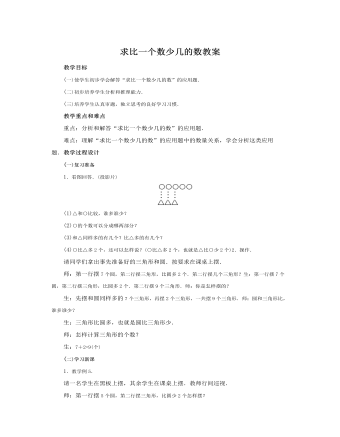
人教版新课标小学数学二年级上册求比一个数少几的数教案
课堂教学设计说明求比一个数少几的数的应用题是低年级教学的一个难点.为了分散难点,在复习准备阶段做了孕伏.如:圆比三角形多2个,也可以说三角形比圆少2个.为了突破难点,让学生动手摆、动口说、动笔写,全方位地调动学生的各种感官参与教学全过程,使学生在参与学习的活动中领悟出“求比一个数少几的数”的应用题仍然是把较大数看作两部分组成的,从大数中去掉大数比小数多的部分,就是小数与大数同样多的部分,也就是小数的数值.也可以通过“假设同样多”去透彻地理解比一个数少几的实际意义.确实使学生理解和掌握了这类应用题用减法计算的道理和解答方法.为了让学生进一步加深理解和掌握“求比一个数少几的数”的应用题的数量关系和解答方法,在巩固练习的最后设计了一组对比题目.
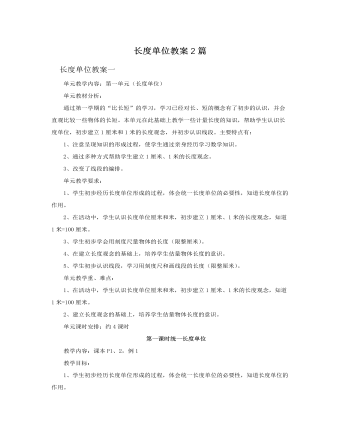
人教版新课标小学数学二年级上册长度单位教案2篇
l尺子上每相邻的两条长刻度线之间的一大格的长度都是1厘米。师:我们大家现在一起用手比划一下,1厘米多长。互相看一下,计住了吗?闭上眼睛想一想,1厘米有多长。3、认识几厘米师:我们现在知道1厘米有多长了,那3厘米又有多长呢?师:同学们还能在尺子上找到其他3厘米的长度吗?4、用厘米量师:刚才上课时,老师展示的2根线绳,到底哪一根长一点呢?现在,同学们先估计一下这两根线绳各自多长,然后在测量比较一下,好吗?师:结果是哪根线绳长一点呢?能说说你是怎么量的吗?三、知识拓展1、师:老师这里有一把尺子,可是它断了一节,没有刻度“0”,只剩下刻度3到刻度10,那么这把尺子能不能用来量物体的长度啊?同学们能不能帮老师想一想办法,好吗?2、其他测量长度的工具(课件展示)
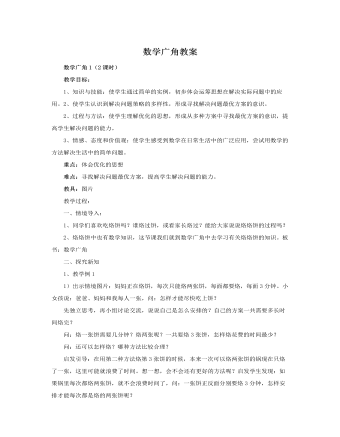
人教版新课标小学数学四年级上册数学广角教案
教学目标:知识与技能:1、使学生初步体会对策论方法在解决实际问题中的应用。2使学生认识到解决问题策略的多样性,形成寻找解决问题最优方案的意识。3、培养学生的应用意识和解决实际问题的能力。过程与方法:使学生理解优化的思想,形成从多种方案中寻找最优方案的意识,提高学生解决问题的能力。情感、态度和价值观:使学生感受到数学在日常生活中的广泛应用,尝试用数学的方法解决生活中的简单问题。重点:体会优化的思想难点:寻找解决问题最优方案,提高学生解决问题的能力。教具:图片教学过程:一、情境导入:1、你们听过“田忌赛马“的故事吗?田忌是怎样赢了齐王的?谁能给大家讲一讲这个故事?2、问:田忌的马都不如齐王的马,但他却赢了?这是为什么呢?3、这节课我们就来研究研究。板书课题:数学广角

人教版新课标小学数学三年级上册多位数乘一位数教案2篇
教学内容:口算乘法教学目标:使学生加深对乘法含义的理解,让学生知道生活中处处有乘法。教学重点:通过观察能熟练用乘法问题。教学过程:一、复习。6×48×59×77×56×89×7二、结合生活情况使学生加深体会乘法的含义。1、教学p68的主题图。(1)、让学生独立观察教科书p68中情境图。思考:①、这幅画面是什么地方?②、你发现了画面中有什么游戏项目。(2)、在小组中互相说说自己观察到了什么内容。(3)、各小组代表汇报。(4)、教师板书学生汇报的数据。(5)、师:根据你们提供的信息(条件),你能提出用乘法计算的问题吗?大家在小组里议一议。2、感知生活中有乘法。(1)、学生汇报。(略)(2)、师:这些活动,你们在哪亲身体验过呢?3、体会生活中的数学问题。师:除以上这些数学问题,你们谁还能提出其他的数学问题,并使用乘法计算?学生通过思考,自由回答。
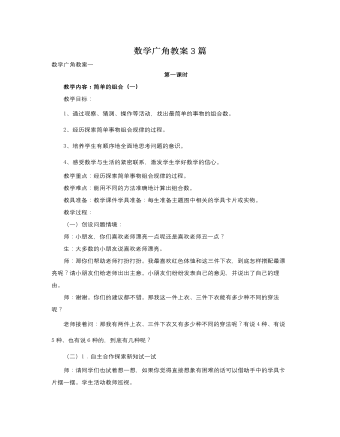
人教版新课标小学数学三年级上册数学广角教案3篇
(一)创设问题情境:师:小朋友,你们喜欢老师漂亮一点呢还是喜欢老师丑一点?生:大多数的小朋友说喜欢老师漂亮。师:那你们帮助老师打扮打扮。我最喜欢红色体恤和这三件下衣,到底怎样搭配最漂亮呢?请小朋友们给老师出出主意。小朋友们纷纷发表自己的意见,并说出了自己的理由。师:谢谢。你们的建议都不错。那我这一件上衣、三件下衣能有多少种不同的穿法呢?老师接着问:那我有两件上衣、三件下衣又有多少种不同的穿法呢?有说4种、有说5种、也有说6种的,到底有几种呢?(二)1.自主合作探索新知试一试师:请同学们也试着想一想,如果你觉得直接想象有困难的话可以借助手中的学具卡片摆一摆。学生活动教师巡视。2.发现问题学生汇报所写个数,教师根据巡视的情况重点展示几份,引导学生发现问题:有的重复了,有的漏写了。
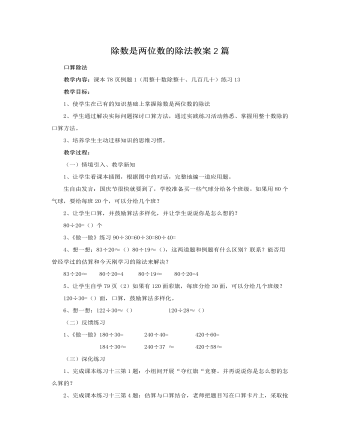
人教版新课标小学数学四年级上册除数是两位数的除法教案2篇
教学目标:1、使学生在已有的知识基础上掌握除数是两位数的除法2、学生通过解决实际问题探讨口算方法,通过实践练习活动熟悉、掌握用整十数除的口算方法。3、培养学生主动迁移知识的思维习惯。教学过程:(一)情境引入、教学新知1、让学生看课本插图,根据图中的对话,完整地编一道应用题。生自由发言:国庆节很快就要到了,学校准备买一些气球分给各个班级。如果用80个气球,要给每班20个,可以分给几个班?2、让学生口算,并鼓励算法多样化,并让学生说说你是怎么想的?80÷20=()个3、《做一做》练习90÷30=60÷30=80÷40=4、想一想:83÷20≈()80÷19≈(),这两道题和例题有什么区别?联系?能否用曾经学过的估算和今天刚学习的除法来解决?

人教版新课标小学数学四年级上册大数的认识教案
教学建议:亿以内数的读法是在万以内数的认识基础上进行教学的,主要是让学生用已有的知识去类推,所以在教学本课时我们有必要对万以内数的认识进行有针对性的复习。如可采用口答形式复习数位顺序及各数位之间的十进关系。对于万以内数的读法,可以出示一组数据如:2005年路桥区前两个月共实现农林、渔业总产值17013万元,其中农业产品6383万元,林业产值94万元,渔业产值7560万元。在对万以内数复习的基础上我们再出示第2页主题图,让学生读一读画面上呈现的6个大数,也可以让学生说说身边听到,看到的大数。在这环节中我们就让学生凭着自己的理解运用旧知识去读数。这里学生肯定会造成认知上的冲突,从而引入新课教学。新课时可以按以下环节进行:1、计数器操作,认识计数单位用计数器数数,拨上一万,然后一万一万地数,一直数到九万后,再加一万是多少?认识十个一万是十万,用同样的方法,完成一百万,一千万,一亿的认识。
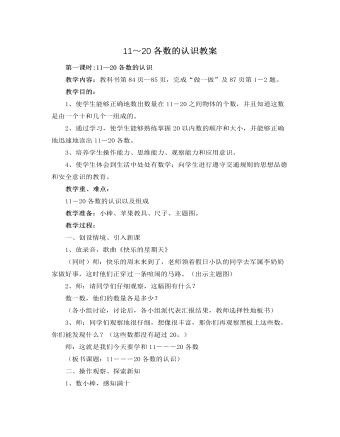
人教版新课标小学数学一年级上册11~20各数的认识教案
教学难点:能用多种方法进行计算。教学准备:计数器、小棒、投影片等。教学过程:一、创设情景(投影出示)在一个美丽的大森林里,一天早上,二只松鼠提着一个篮子上山采松果,松鼠妈妈采了14个,松鼠宝宝采了3个,然后就一起高高兴兴地回家去了。(学生看图,然后让学生根据图意编一个小故事,比一比,看谁编的故事最有趣)1、指名编故事。2、有谁能提出有关的数学问题。(先同桌互相说,然后再指名说)教师根据学生的回答进行选择性的板书:(1)一共有多少个松果?(2)松鼠妈妈比松鼠宝宝多采多少个?(3)松鼠宝宝比松鼠妈妈少采多少个松果?(4)松鼠宝宝还要采多少个才能和松鼠妈妈采的同样多?3、先解决第一个问题:问:(1)要求一共有多少个松果?用什么方法计算?如何列式?为什么用加法计算?说一说你的理由?还有谁能说?(2)14+3=?你是怎样算的?同桌互说算法,然后指名说。
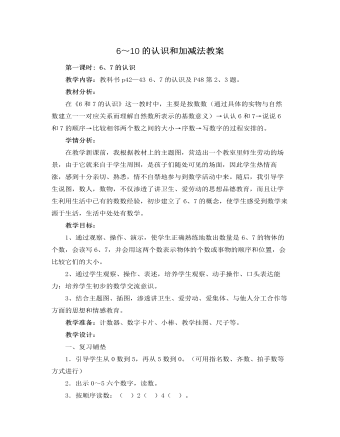
人教版新课标小学数学一年级上册6~10的认识和加减法教案
四、全课总结[设计意图:通过电教媒体把抽象的数学知识与学生的心理和生活中喜欢做游戏的特点结合起来,使学生在乐中学,在玩中学,有利于学生对知识的理解和掌握。]教学反思:根据学生年龄小、活泼好动的特点,我在教学中力求激发学生学习的积极性、主动性,使学生在愉悦和谐的课堂气氛中获取新知,并培养了学生的多种能力。第十五课时: 生活中的数教学内容:教科书第46页、第57页、第87页“生活中的数”。教材分析:本节课教师通过课件演示,创设生活情境,在现实世界中寻找生活素材,成功地将学生的视野拓宽到他们熟悉的生活空间。然后通过说一说、摆一摆、猜一猜、算一算等实践活动,让学生感觉到数学就在他们身边,看得见、摸得着。学生自始至终地参与观察、操作、猜测、验证、思考等多种实践活动,积极性非常高。可以说,我在围绕“数与生活”这一中心设计教学活动时,也在积极地进行构建“生活数学”教学体系的探索与尝试。
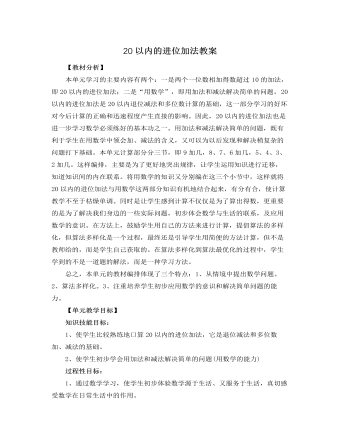
人教版新课标小学数学一年级上册20以内的进位加法教案
教学目标:1、通过多种形式的练习,提高学生的计算速度和正确率。2、培养学生看图表的能力,初步渗透统计思想。3、培养学生学习数学的兴趣,同时培养学生的数感。教学重、难点:熟练掌握计算方法并能够进行正确的计算,能够有效的提高计算速度及正确率教学过程:一、基本练习1、口算10-38+49-1 9-88+215+38+77+55+6 3+911-19+68+86+78+6 9+82+93+102、()里应填什么数?(1)比9大2的数是(),比7多4的数是()。(2)写出得数是13的四道算式?( )、()、( )、()(3)练习9+()=13 8+()=1512-()=2()+7=14()+()=12 ()+()=19二、指导练习练习二十一第4题(1)学生看书,弄清题目的意思。问:这题是什么意思?(2)分组讨论,并派代表说一说。(3)教师板书,引导学生看统计表。指导学生看表:表的第一竖行画有皮球、毽子、跳绳;第二竖行上面写着“一班有”,下面的数就是一班有这三种体育用品的数量,即一班有7个皮球、5个毽子、4条跳绳;
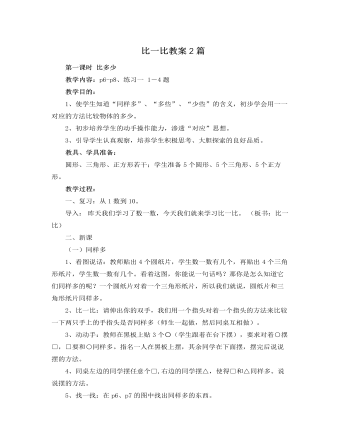
人教版新课标小学数学一年级上册比一比教案2篇
(1)我们比较铅笔的长度,可以说这支铅笔长些、那只铅笔短些;如果我们比较两名同学的身高,应该怎么说?(引导学生说出“高矮”)(板书:高矮)(2)(请两位身高相差较大的同学站起来)谁比较高?谁比较矮?(3)(请两位身高相差不大的同学站起来)能不能一眼看出来,谁比较高,谁比较矮?你有什么方法可以比较出他们两个谁比较高?(小组讨论)(4)小组汇报(5)现在我们来玩一个排队的游戏,四人小组按照从高到矮的顺序排队。(6)练习一 7、8、 4、小结:今天我们学了比较长短、比较高矮的方法。其实除了我们今天所说的方法之外,还有很多种方法,我希望同学们多动动脑筋,想出更多更好的方法。教学反思:在学习《长短、高矮》时,通过老师和学生、学生与学生比高矮,利用手边的铅笔、尺等来比长短,使学生理解长短、高矮是相比较而言的。这些事例是学生身边的,学生看的见、有体验、说的出来、易于理解的。因此,学生学起来容易,而且能够正确的加以运用。
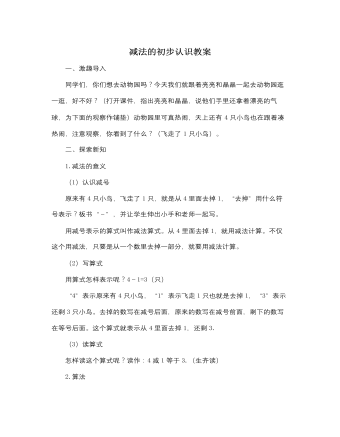
人教版新课标小学数学一年级上册减法的初步认识教案
一、激趣导入同学们,你们想去动物园吗?今天我们就跟着亮亮和晶晶一起去动物园逛一逛,好不好?(打开课件,指出亮亮和晶晶,说他们手里还拿着漂亮的气球,为下面的观察作铺垫)动物园里可真热闹,天上还有4只小鸟也在跟着凑热闹,注意观察,你看到了什么?(飞走了1只小鸟)。二、探索新知1.减法的意义(1)认识减号原来有4只小鸟,飞走了1只,就是从4里面去掉1,“去掉”用什么符号表示?板书“-”,并让学生伸出小手和老师一起写。用减号表示的算式叫作减法算式。从4里面去掉1,就用减法计算。不仅这个用减法,只要是从一个数里去掉一部分,就要用减法计算。(2)写算式用算式怎样表示呢?4-1=3(只)“4”表示原来有4只小鸟,“1”表示飞走1只也就是去掉1,“3”表示还剩3只小鸟。去掉的数写在减号后面,原来的数写在减号前面,剩下的数写在等号后面。这个算式就表示从4里面去掉1,还剩3.
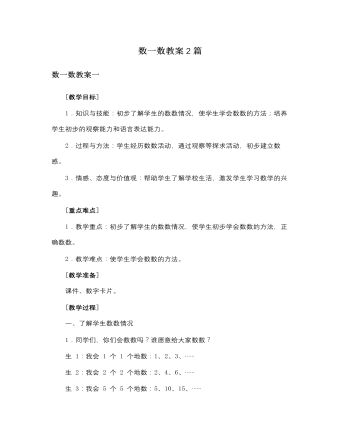
人教版新课标小学数学一年级上册数一数教案2篇
[在学生数的过程中再加强点数的指导,同时有意识的培养学生按顺序数数。另外,在数六朵花、八棵树、九名女生、十名男生的时候,除了 1 个 1 个地数以外,还可以引导学生 2 个 2 个地、3 个 3 个地、4 个 4 个地、5 个 5 个地数数,为后面学习 10 以内各数打基础。] (2)小组进行交流。 再从 1~10 数一数物体的个数。 (3)认一认。 师:你认识这些数吗?边指边读给大家听听。 生:边指 1~10 各数边读一读。 三、巩固练习 1.结合实物,开展数数活动。 (1)按要求数出下面物体的个数。 师:同学们刚才数得真不错!你们愿不愿意数一数自己文具盒中有几支铅笔呀? 生:数出自己文具盒中有几支铅笔并汇报。 师:请同学们数一数你的书包里共有几本书? 生:数出自己书包里共有几本书并汇报…… (2)自由数物体的个数。 师:你还想数哪些物体的个数?和同桌的小伙伴交流一下。
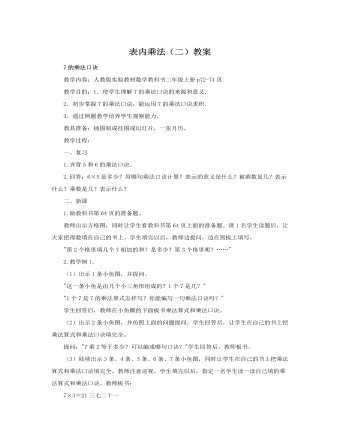
人教版新课标小学数学二年级上册表内乘法(二)教案
三、利用乘法口诀进行计算1.复习口诀的含义。任意挑出一句乘法口诀(两个因数不同的),让学生说说它表示什么意思。如"七八五十六",使学生知道它既表示8个7相加是56,又表示?个8相加是56。2.以游戏的方式开展用口诀进行计算的活动。(1)已知两个因数求积的游戏。方法是:请一位学生随意说出一个两位数,另一位学生则将这个两位数的十位数字与个位数字相乘,并算出结果,如果结果又是一个两位数,再将这个两位数的十位数字和个位数字相乘,直至结果是一位数或零。如,一位学生说:"79",另一位学生则口算:7X9=636X3=181X8=8;一位学生说:"58":另一位学生口算:5X8=404X0=0(告诉学生0和一个数相乘得零)一位学生报了3个数以后,互换角色进行。(2)已知积求两个因数的游戏。
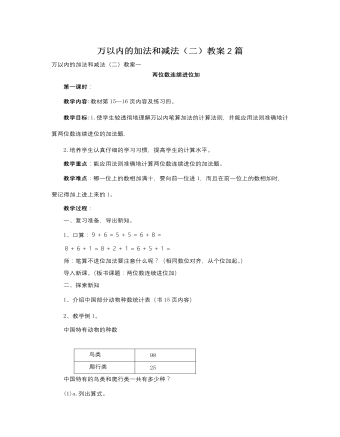
人教版新课标小学数学三年级上册万以内的加法和减法(二)教案2篇
●教学内容:教科书第27页的内容。●教学目标:①通过创设具体的情境,使学生初步学会加法的验算,并通过加法验算方法的交流、让学生体会算法的多样化。②培养学生探索合作交流的意识和能力。③让学生用所学到的验算知识去解决生活中的问题,体会用数学的乐趣。●教具准备:老师准备挂图或课件。●教学过程:创设情境、导入新课。师:同学们,你们与爸爸、妈妈去超市买过东西吗?生:互相说说,再请同学发表意见。师:(挂图1)我们来看挂图,小明和妈妈去超市买东西,从图1中你看到了什么?生1:从图1中我看到了小明妈妈买了一套135元的运动服和一双48元的运动鞋。生2:从图1中我看到小明妈妈给了售货员200元。生3:要知道一套运动服和一双运动鞋一共要多少元?应用加法计算。师:全班动手计算。板书:135+48=183(元)
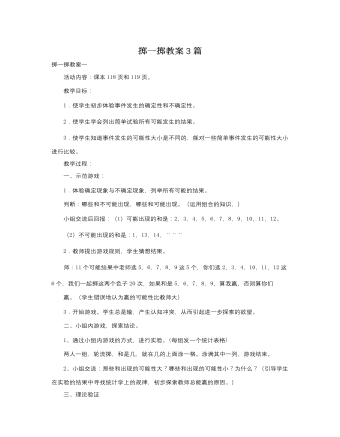
人教版新课标小学数学三年级上册掷一掷教案3篇
3、开始游戏。学生总是输,产生认知冲突,从而引起进一步探索的欲望。(二)小组内游戏,探索结论。通过小组内游戏的方式,进行实验,利用统计的方式呈现实验的结果,初步探索教师总能赢的原因。要引导学生在实验的结果中寻找统计学上的规律。(三)理论验证通过组合的理论来验证实验的结果。可以用不同的方式来进行组合,让学生探讨每个“和”所包含的组合情况的多少与这个“和”出现的次数之间的关系。三、师生共同小结本次活动1、通过本次活动,你有什么新的收获?2、师生总结:本次活动通过猜想、实验、验证等过程,让同学们在问题情境中自主探索,解决问题,既发展了同学们的动手实践能力,又充分调动了同学们的学习兴趣。
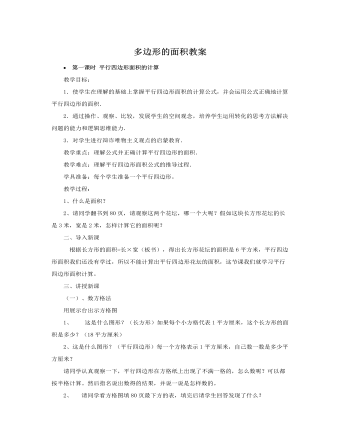
人教版新课标小学数学五年级上册多边形的面积教案
教学目标: 1.理解、掌握梯形面积的计算公式,并能运用公式正确计算梯形的面积。2.发展学生空间观念。培养抽象、概括和解决实际问题的能力。3.掌握“转化”的思想和方法,进一步明白事物之间是相互联系,可以转化的。教学重点:理解、掌握梯形面积的计算公式。教学难点:理解梯形面积公式的推导过程。教学过程:1.导入新课(1)投影出示一个三角形,提问:这是一个三角形,怎样求它的面积?三角形面积计算公式是怎样推导得到的?学生回答后,指名学生操作演示转化的方法。(2)展示台出示梯形,让学生说出它的上底、下底和各是多少厘米。(3)教师导语:我们已学会了用转化的方法推导三角形面积的计算公式,那怎样计算梯形的面积呢?这节课我们就来解决这个问题。(板书课题,梯形面积的计算)

